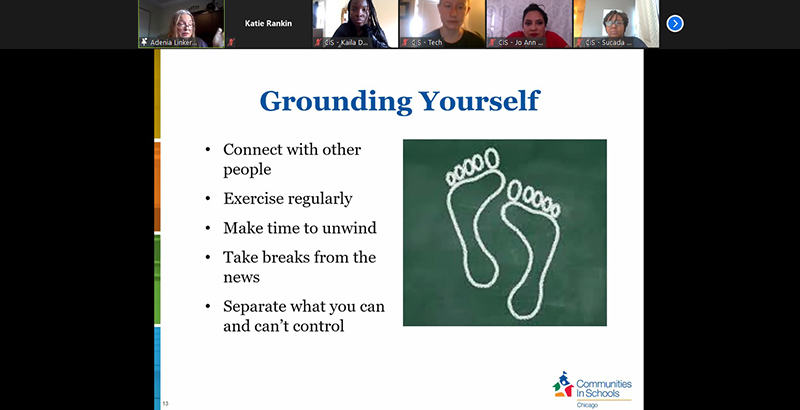Linker: How My Chicago Collaborative Supports Social-Emotional Health of Students, Teachers & Families Amid Online Learning and COVID Stress

In its 2020-21 remote learning plan, Chicago Public Schools identified supporting the social and emotional well-being of students and their families as a key priority. “During this time of uncertainty and disruption, our students may feel a sense of loss, grief, anxiety and depression,” the plan states, “while students who are exposed to chronic stress and trauma are especially vulnerable.”
How can educators respond and foster a sense of belonging for students, in addition to teaching academic curricula? That’s where Together for Students comes into play. Together for Students is a three-year initiative that focuses specifically on fostering young people’s social and emotional learning.
In Chicago, Together for Students brings together three organizations — Communities In Schools (CIS) of Chicago, Chicago Public Schools and Thrive Chicago — and as the representative for CIS of Chicago, I work with my counterparts to help integrate social and emotional learning strategies both inside and outside the classroom.
Supporting educators in social and emotional learning was important for student success even before the pandemic, but it’s now more crucial than ever amid remote learning and the stress that has bubbled up this year. Through virtual trainings, e-newsletters, resource lists, panels and more, my counterparts at the Together for Students initiative have brainstormed creative ways to keep students connected. And I’m proud to say that my colleagues at CIS of Chicago have employed many of these strategies throughout the remote learning period.
Here are some ideas we’ve gleaned from experience and discussion to help guide educators in SEL support this school year.
Student Support
Focus on one social-emotional learning competency as a daily theme each week: For example: Monday Mindfulness (self-awareness); Tuesday Truth and Justice (social awareness); Wednesday Wellness (self-management); Thursday Thinking Ahead (responsible decision-making); Friday Friendship (relationship skills)
Host a virtual morning meeting: This creates ways for students to build connections, even at home, whether it’s a check-in circle, social and emotional activities or a group mindfulness or exercise session. This can also work as a virtual town hall or cafeteria safe space for high school students to have their voices heard. One of my CIS of Chicago colleagues hosts a check-in group at a K-8 campus in Chicago’s Bronzeville community for middle schoolers to discuss their thoughts and concerns.
Record and share videos or audio clips: These can take the place of the announcements that students would usually hear over the intercom: birthday shoutouts, important resource information, updates on school policies or classroom content.
Keep virtual, drop-in office hours: This gives students an opportunity to seek out human interaction. One of my colleagues who is embedded at an elementary school on Chicago’s Southwest Side hosted virtual office hours when remote learning began, just in case students needed a friendly face to chat with.
Take your class on a virtual field trip: Many museums are offering digital tours. Add a scavenger hunt so students can explore individually, then regroup to share findings in a chat room or videoconference session.
Staff Support
Host virtual lunch-and-learns around SEL for staff: Invite guest speakers or feature hot topics that can be covered in under an hour.
Gather staff virtually, by grade level, to coordinate SEL supports: Collaborative planning ensures that students receive a variety of SEL, activities such as emotional check-ins and reflective journal writing. Through collaboration, staff learn where they can build on one another’s work. At one of CIS’s West Side high school partners, for example, my colleague coordinates social-emotional programing for 10th-graders that aligns with the school’s broader focus on health, wellness and safety.
If it works, share it across the school or network: One math teacher designated breakout sessions based on cat pictures. By the end of the week, cats were the go-to (and fun) way to organize students for small-group work — and the students were loving it.
Parent and Family Support
Create a drive or shared folder for SEL across campus, as well as one for parents and caregivers: This could include a resource or phone list for social services. In collaboration with the Behavioral Health Team at one of our North Side partner schools, another of my CIS colleagues is continuing to source and share a resource list this fall with school leaders and families.
Send daily or weekly video newsletters to families: Consider recording yourself reading a children’s book, conducting a science experiment in the kitchen or demonstrating a DIY tip.
As we turn the calendar to 2021, our nation’s school children face a momentous transition: a return to in-person learning. They will rely more than ever on their teachers, parents and other caring adults to help them feel safe and reacclimate to a novel (but familiar) experience. Focusing those efforts on rigorous teaching practices and social-emotional learning is a pathway to certain progress.
Adenia Linker is the Together for Students project manager for Communities In Schools of Chicago, which works to ensure that every public school student graduates high school prepared to succeed in life. The ideas in this essay were the result of a collaboration with the Chicago Public Schools Competency-Based Education Network and educators Nilufar Rezai, Shannae Jackson and Julia Ciciora. For more information, visit cisofchicago.org.
Get stories like these delivered straight to your inbox. Sign up for The 74 Newsletter

;)